Trailing the Mayflower - The Iconic Ship of a Pilgrim Voyage to the New World
One of the most famous voyages from England to Virginia was on the Mayflower. This ship became the symbol of the search for a new life and pilgrimage to the New World in the 17th century. 2020 marks the 400 year anniversary of this historic vessel’s iconic voyage.
The origins of the Mayflower are uncertain however it is known that the ship was bought around 1607 by Christopher Jones and his business partners. The first well-documented voyage of the ship happened in 1609. The destination was Trondheim in Norway. It was hired by Andrew Pawling to take cargo from London to Norway. The crew was also instructed to buy tar, fish, and lumber and bring it back to England. Unfortunately, the crew lost most of the goods during a storm. After this situation, the Mayflower traveled for the same purposes to France, Spain, and Germany.
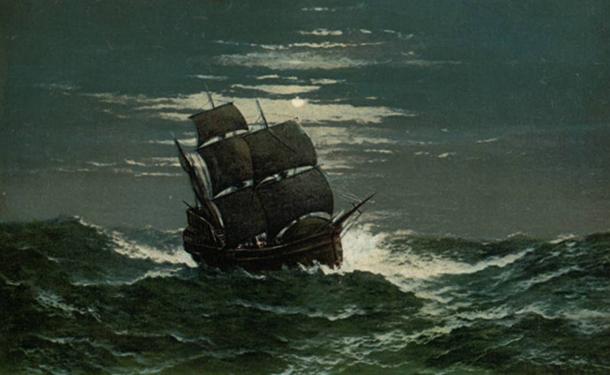
The Mayflower at sea. (Public Domain)
The Mayflower was a classic merchant ship built in the 17th century. It was square-rigged, beak-bowed, and could travel with 180 tons of cargo. It measured about 100 feet (30.5 m) in length and 25 feet (7.5 m) at its widest point. The Mayflower wasn't created to sail on the ocean and it didn't sail well against the wind. But when Jones and his crew returned from Bordeaux, France, in May 1620, they were hired for a special voyage…
The Mayflower’s Voyage into the Unknown
The Mayflower started its legendary voyage from Plymouth to the New World in September 1620. Apart from a crew of around 30 people, there were 102 passengers on the ship. The pilgrims paid Jones to take them to northern Virginia.
Jones was a 50-year-old man from Essex, England. He was a sea veteran who valued money and freedom. He appreciated his lifestyle as a sailor, and did not treat the travel to Virginia as anything more than another job.
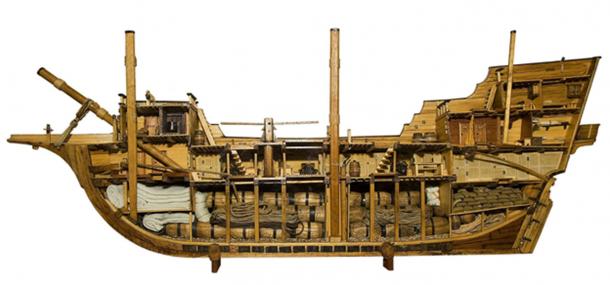
Model of a typical merchantman of the period, showing the cramped conditions that had to be endured. (CC BY-SA 3.0)
The men, women, children, and animals on the Mayflower faced the same difficulties as others who made the voyage across the Atlantic Ocean during the times of the colonization of North America. Jones had never been in the New World before, but some of his co-workers, like Robert Coppin and John Clarke (the master mates), had been there before. The passengers were not ready for the cold and other weather conditions and they suffered from tuberculosis, pneumonia, and scurvy. Two passengers died and a baby girl named Oceanus was born at sea.
- The American Tradition of Thanksgiving: A Harvest Festival with Roots in the Old World
- Would you take a Medieval Journey? Man recreates Pilgrimage across England with period supplies only
The Mayflower arrived in the New World a few weeks after it left England. The crew reported on November 9, 1620, that they sighted land in the area which is currently known as Cape Cod. The ship went back to England in April 1621. It left a group of people behind, who were not the first settlers on the continent, but they did create a few iconic symbols for the future United States of America.
A New Home in Virginia
The pilgrims created Plymouth Colony, supported with an agreement signed in 1620. It was the main legal instrument to confirm the arrival and creation of new settlements in New England. The text of the Mayflower Compact was published on November 11, 1620, but it received its name in 1793. The document, written by the new inhabitants of New Virginia, became the basis for the future Declaration of Independence and constitution of the USA. The document stated:
''In the name of God, Amen. We whose names are underwritten, the loyal subjects of our dread Sovereign Lord King James, by the Grace of God of Great Britain, France, and Ireland King, Defender of the Faith, etc. Having undertaken for the Glory of God and advancement of the Christian Faith and Honour of our King and Country, a Voyage to plant the First Colony in the Northern Parts of Virginia, do by these presents solemnly and mutually in the presence of God and one of another, Covenant and Combine ourselves together in a Civil Body Politic, for our better ordering and preservation and furtherance of the ends aforesaid; and by virtue hereof to enact, constitute and frame such just and equal Laws, Ordinances, Acts, Constitutions and Offices from time to time, as shall be thought most meet and convenient for the general good of the Colony, unto which we promise all due submission and obedience. In witness whereof we have hereunder subscribed our names at Cape Cod, the 11th of November, in the year of the reign of our Sovereign Lord King James, of England, France and Ireland the eighteenth, and of Scotland the fifty-fourth. Anno Domini 1620.''
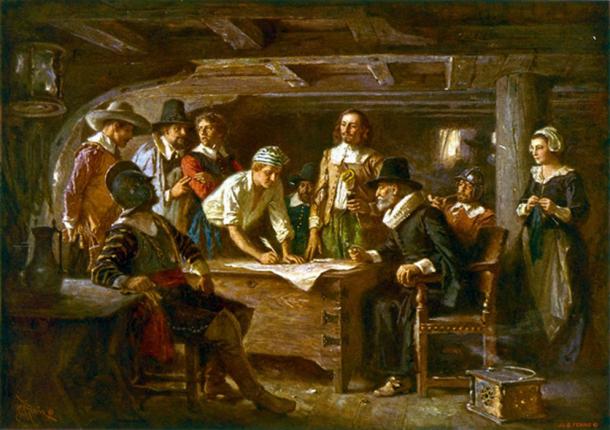
Signing the Mayflower Compact 1620, a painting by Jean Leon Gerome Ferris 1899. (Public Domain)
Apart from their defensive fort, houses, and community storehouses, the people who arrived in northern Virginia also built a meetinghouse to hold their church services, court sessions, and town meetings. In 1621, the colonists of Plymouth celebrated the holiday Thanksgiving, which was a harvest feast after a good growing season. A previous Ancient Origins article describes how vital the Pokanoket tribe were to that day:
The Pokanoket tribe, as the Wampanoag nation was also known, saved the Mayflower Pilgrims from starvation in 1620-’21 despite apprehension they felt because of violence by other explorers earlier in history. But early on the Pilgrims made a peace pact with the Pokanoket, who were led by Chief Massasoit. One Indian, Tisquantum or Squanto could speak English. He and his people taught the Pilgrims what they needed to know about farming in the area that became known as New England. In November 1621 the natives and Pilgrims celebrated what we call Thanksgiving.
The Ship’s Significance
In 1622, Jones died of a mysterious disease which he had contracted in the New World. He is buried at St Mary’s Church in Rotherhithe, London, England. The Mayflower awaited a new fate for the next two years. However, it was considered an old ship and not useful, so it was either taken apart and used as timber to build a barn, or rebuilt into a new ship.
Nevertheless, the legend of the Mayflower was already very strong, so the English built a new ship with the same name. It brought 35 passengers from London to the colony in Plymouth in 1629 and it transported passengers between the two continents until about 1642. Pilgrim journeys to America started in 1608, but the Mayflower's passengers made one of the biggest impacts on the new society, and opened a new chapter in history.
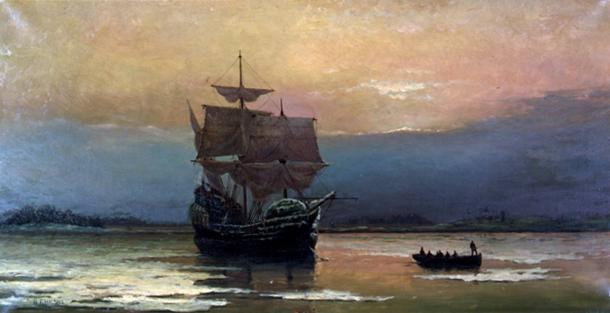
Mayflower in Plymouth Harbor by William Halsall (1882). (Public Domain)
A Challenging Legacy: Mayflower 400
In 2020, the Wampanoag, United States of America, Netherlands, and the United Kingdom have been commemorating the 400th anniversary of the Mayflower's famous voyage. The nations had planned many exciting events for Mayflower 400, however several programs have had to be changed, conducted online, cancelled, or postponed due to the current pandemic. One of the ambitious projects that has been completed is the Virtual Mayflower project – a VR model of the Mayflower ship.
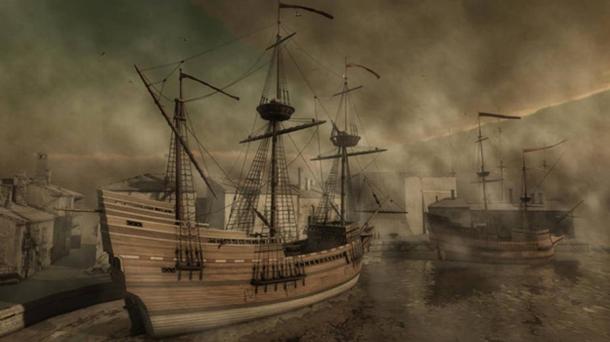
An image showing early VR models of the Mayflower and Speedwell. The Speedwell was left behind in Sutton Pool after two attempts to make the transatlantic crossing failed. (HIT Team, University of Birmingham)
According to the Mayflower 400 website, the main goal is “an honest, broad and inclusive commemoration of the ship’s sailing from England to America and its often challenging legacy.” The project leaders are exploring themes of migration, humanity, oppression, persecution, loss, and freedom. Despite the setbacks, Mayflower 400 is still underway and will continue into 2021.
Top Image: Mayflower II – this is a replica of the 17th century Mayflower ship. Source: Jim Curran /Adobe Stock
Updated on November 24, 2020.
References:
Nathaniel Philbrick, Mayflower: A Story of Courage, Community and War, 2006.
www.history.com/topics/thanksgiving/history-of-thanksgiving
https://www.themayflowersociety.org/
http://www.perseus.tufts.edu/hopper/text?doc=Perseus%3Atext%3A2005.05.0026%3Achapter%3D2
http://mayflowerhistory.com/voyage/
http://www.history.com/topics/mayflower
http://www.plimoth.org/learn/just-kids/homework-help/mayflower-and-mayflower-compact


















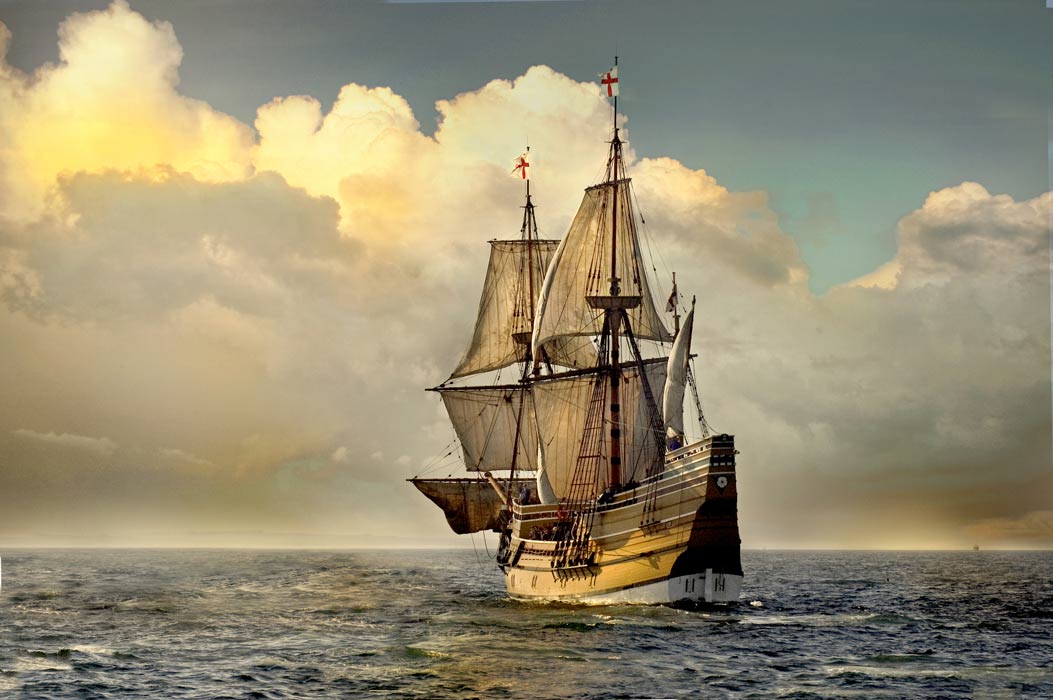
Comments
Hi All,
All I can say about Mayflower & Thanksgiving is at least they finally taught The Real History of Mayflower &
The Wampanoag People.
I think what amazed me is the pilgrims came to New Canaan I'm surprised Plymouth Massachusetts wasn't renamed Canaan to begin with for Freedom of Religion experiencing Intolerance from England; only too come to The New World and return that same intolerance to Indigenous Tribe's, and Quakers.
I'm serious I watched this Finding your Root's episode and a few people on this program Dr. Gates and his Team traced; all the way back too The Puritans right in the middle of the 1600's, before we're known as America.
A relative participating on the show discovered that their great-grandfather was arrested and tried for giving shelter to some Quakers. It was nighttime and so Storming really bad I'm talking thunder & lighting, downpour at night before the day street lamps existed not too mention the bitter cold.
The Quakers knocked on his Door for shelter from The Storm He the Puritan Christian opened that Door and gave shelter to the Quakers in that awful Storm.
The Puritan Man wound up going to jail for giving shelter to the Quakers during a Storm; that's when Dr. Gates explained that back in England that the Puritans fled from King James had Quakers Executed it seems Hate towards The Quakers came with The Puritans it's shocking really.
The man wound up being excommunicated from The Puritan Community The Quakers he show Christian Love too? They took Him in and traveled elsewhere in Massachusetts to a place that became Quaker Capital,
of The State of Massachuettes as for the Excommunicated Puritan wouldn't you know He became Quaker.
The Quaker Capital would become an economic goldmine in the long run The Whaling Industry would start there.
This is what I think of when reading up on history of The Pilgrims and strain relations with The Indigenous Tribes in general.
Time for me too go so until next time Everyone, Goodbye!
This article has a number of problems that maybe they don’t teach in grade school anymore:
1. There were only two deaths on the journey– a crewman (who had been at odds with the Pilgrims and was “struck down by God”) and William Bradford’s wife, who “fell” off the boat at anchorage where Provincetown is now, so she actually survived the journey. The deaths came about because of the harsh winter and lack of supplies; as Caroline noted above, the Mayflower could not carry all their needs – the Speedwell was supposed to bring more. The French seizure/blockade of English ships during the siege of LaRochelle also put strains on the supply of the colony (see Comment 5).
2. The Pilgrims did not start a “Church of England”. They were Separatists and wanted to worship separately from the Church of England.
3. My understanding is that Christopher Jones died in the New World, either in 1621 or on a later voyage, not in France.
4. About 20 years ago, maybe more, there were news articles (e.g., Newsweek) that someone had supposedly discovered the remains of the Mayflower incorporated into a barn in Kent or elsewhere in southern England.
5. An additional reference that might be useful is “Making Haste from Babylon” (sorry, don’t recall author except that he was English) which came out about the same time as Philbrick’s book, which I have not read yet.
I find it hard to believe the Mayflower was only 25feet wide. I had a garage that was on a piece of fenced property that was 35feet wide and 100feet deep and your telling me the Mayflower was ten feet narrower and held all those people, food and belongings? I don't think so!